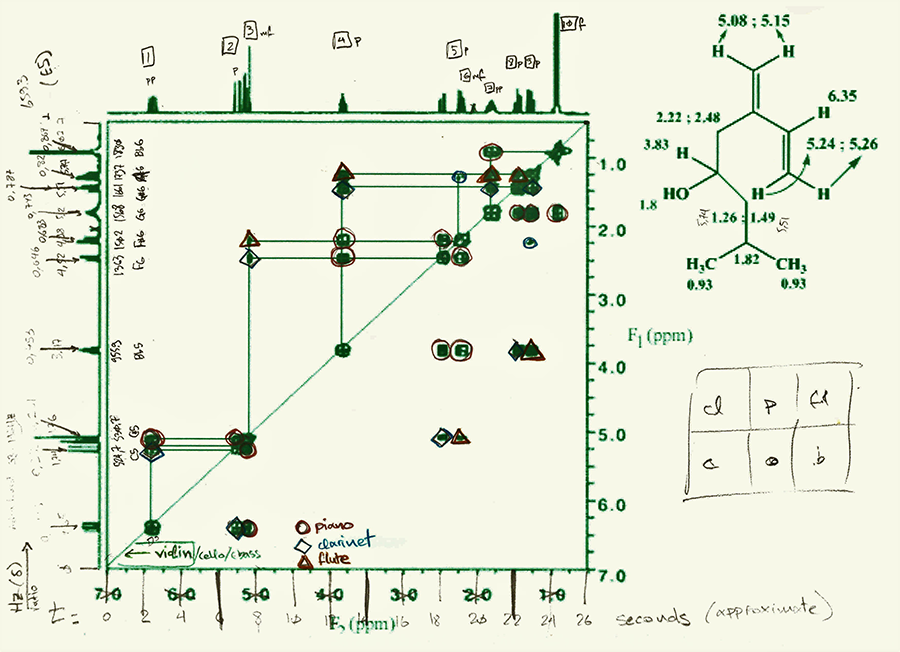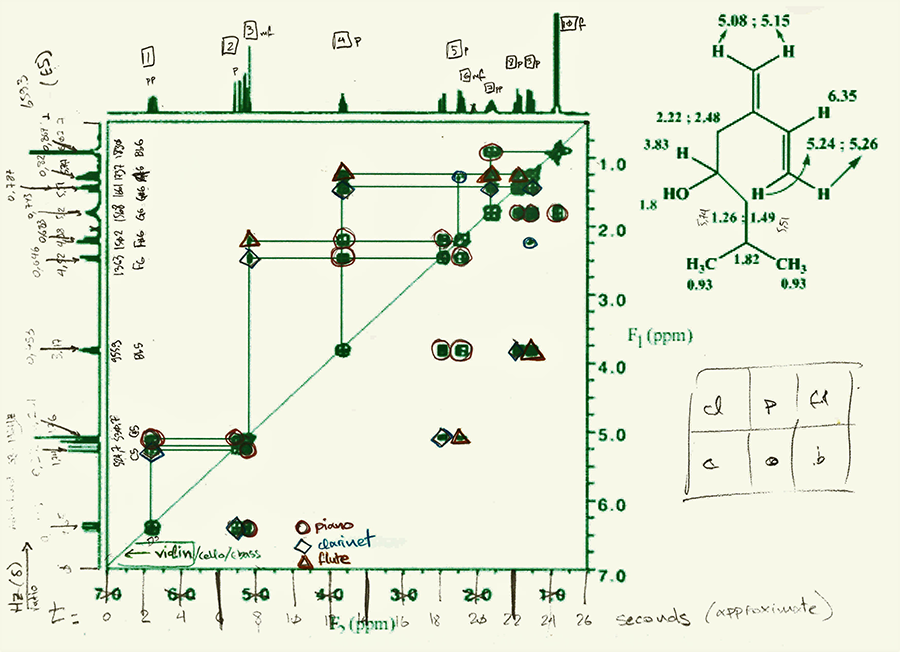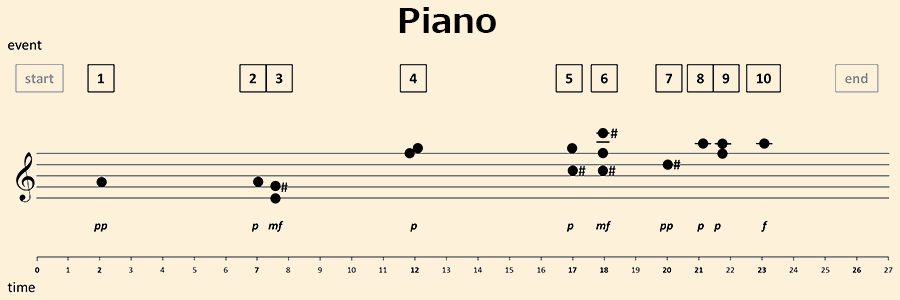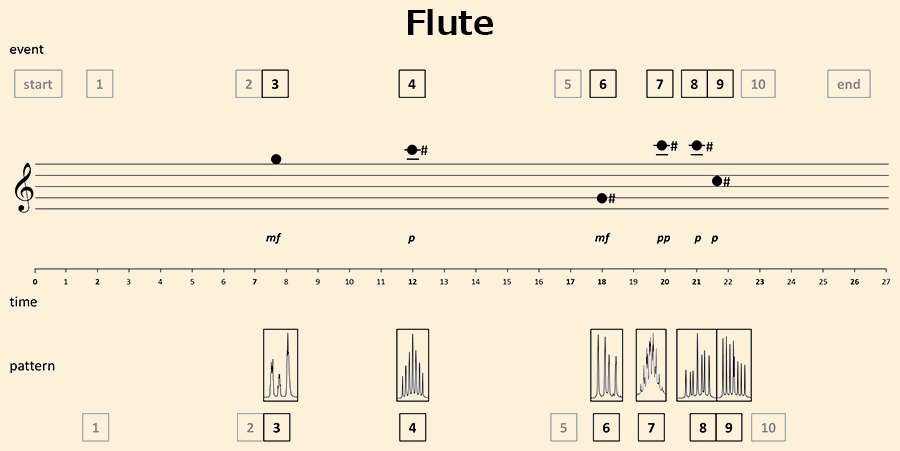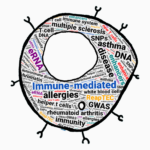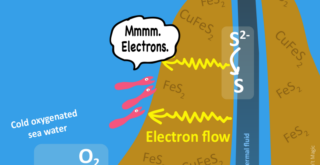One of the first responses to my call for science-inspired art was from a Greek scientist who had composed a musical piece based on the NMR spectrum for the molecule ipsenol. As I had just written a press release for a study that involved NMR, it was really good timing. Almost. Now, after a summer vacation and business trip to ESOF in Manchester (more to come on that), I can finally tell you this interesting story …
First, listen to ipsenol, composed by Thanos Andreou and performed by dissonart ensemble.
Collaborative Miniature Project - Ipsenol
Collaborative Miniature Project - Ipsenol
According to Thanos, his efforts fall in the realm of Nuclear Magnetic Dissonance, which is “attempt to interpret inherent molecular harmonics using musical instruments.” The image you see contains the 2D H-H Correlation Spectrogram of ipsenol. As you’ll (hopefully) read below, an NMR spectrum reflects molecular structure.
Thanos arranged the music for four musical instruments (violin, piano, flute, and B flat clarinet), and kindly provided us with this original scan. But what’s a blah blah blah spectrogram and what’s it got to do with anything?
What is NMR and why should you care?
- NMR stands for nuclear magnetic resonance. It’s similar to an MRI (magnetic resonance imaging), and the point is magnetic resonance, so don’t freak out and think it’s a nuclear reactor or something. It uses magnets and radio waves. Relax.
- NMR Spectroscopy is a way to graph the data. Because different molecules will produce different characteristic spectra, the spectra can be used to identify what you’ve got in a sample.
- It can resolve more details than a “mass spec” analysis, and I’m sure Hodgins wants one at the Jeffersonian (Doh! American pop-culture reference … wait, make that two).
- For example, in the study I wrote the press release for, the researchers (lead by Jun Kikuchi) used NMR to characterize soil that was treated with torrefied biomass. They found that the treated soil (but not the untreated soil) contained certain organic acids that are known to promote plant growth. As a consequence, and with other tests, they concluded that the treatment could improve soil is arid climates.
Below are some details on how NMR works (specifically hydrogen NMR) and what H-NMR spectra tell us. Because the focus here is limited, loads of details are missing. Please don’t cry. If you crave details, just ask! If you don’t care about details, but want to know more about how music was made, go here.
According to Thanos, his efforts fall in the realm of Nuclear Magnetic Dissonance, which is “attempt to interpret inherent molecular harmonics using musical instruments.” The image you see contains the 2D H-H Correlation Spectrogram of ipsenol. As you’ll (hopefully) read below, an NMR spectrum reflects molecular structure.
Thanos arranged the music for four musical instruments (violin, piano, flute, and B flat clarinet), and kindly provided us with this original scan. But what’s a blah blah blah spectrogram and what’s it got to do with anything?
What is NMR and why should you care?
- NMR stands for nuclear magnetic resonance. It’s similar to an MRI (magnetic resonance imaging), and the point is magnetic resonance, so don’t freak out and think it’s a nuclear reactor or something. It uses magnets and radio waves. Relax.
- NMR spectroscopy is a way to graph the data. Because different molecules will produce different characteristic spectra, the spectra can be used to identify what you’ve got in a sample.
- It can resolve more details than a “mass spec” analysis, and I’m sure Hodgins wants one at the Jeffersonian (Doh! American pop-culture reference … wait, make that two).
- For example, in the study I wrote the press release for, the researchers (lead by Jun Kikuchi) used NMR to characterize soil that was treated with torrefied biomass. They found that the treated soil (but not the untreated soil) contained certain organic acids that are known to promote plant growth. As a consequence, and with other tests, they concluded that the treatment could improve soil is arid climates.
Below are some details on how NMR works (specifically hydrogen NMR) and what H-NMR spectra tell us. Because the focus here is limited, loads of details are missing. Please don’t cry. If you crave details, just ask! If you don’t care about details, but want to know more about how music was made, go here.
Resonance
First let’s talk about magnets. You may know that magnets will align themselves so that the ‘+’ end (or north end) of one attaches to the ‘-‘ end (or south end) of the other. If a magnet projects a strong enough magnetic field, other magnets will align themselves in the direction of that field.
Because protons of a hydrogen atom spin around, the atoms act like tiny magnets that can be affected by a large magnetic field. As a consequence, when you project a magnetic field at them with an NMR machine, they align to it. This is called the alpha-spin state, and does not require extra energy.
α-spin: A hydrogen atom aligns its spin to direction of the NMR magnetic field
Things start getting interesting when you hit the hydrogen atoms with low frequency electromagnetic radiation (EM radiation) such as radio waves. Like all electromagnetic radiation, lower frequencies contain lower amounts of energy. If the radio signal has enough energy, the hydrogens flip to align in the direction opposite the magnetic field (the beta-spin state). When the signal is removed, the atoms relax back to the low-energy alpha state, and then actually emit radio waves at the same frequency that caused them to flip. This is called the resonance frequency, and is detected and recorded by the NMR machine.
β-spin + relax: Radio waves at a particular resonant frequency can cause the hydrogen atom to align its spin opposite the direction of the NMR magnetic field.
Electron Shielding
In order to tell molecules apart, H-NMR detects differences in their hydrogen atoms. For example, let’s take two molecules with the exact same molecular formula: alcohol (ethonol) and dimethyl ether (both = C2H2O). So how are the hydrogen atoms different? Well, without getting into too much more detail, the different physical arrangements change how close electrons are to the hydrogen atoms.
This matters because if electrons are close to a hydrogen, they can mess with the NMR magnetic field and prevent the hydrogen atoms from aligning in the alpha-state. This is called electron shielding.
Electron shielding: When electrons shield a hydrogen atom, it does not align to the NMR magnetic field. This means that the hydrogen atom needs to absorb less electromagnetic energy to reach the beta-spin state.
You may have noticed hydrogen always has to rotate 180° when going from the alpha state to the beta state. However, any amount of shielding will reduce how much it has to change from its natural orientation. As a result, shielded hydrogens require less energy to reach the beta state, and thus have lower resonant frequencies. An NMR spectrogram graphs this out, and we see peaks in the graph for each type of hydrogen in the molecule.
Spectrograms
An H-NMR spectrogram for ethanol yield 3 peaks, but the one for dimethyl ether only has one. What’s going on?
The spectrogram: Hydrogen atoms in ethanol occur in 3 electron environments, yielding 3 peaks in the graph. In contrast, hydrogen atoms in dimethyl ether have total symmetry, resulting in only 1 peak.
First, let’s get oriented to the graph. The horizontal axes basically represents the energy needed to flip the atoms. Because this depends on the frequency of the radio waves and the frequency of the NMR itself (and there are many types), the units are given as a ratio between the two, and are called parts per million (ppm). So, a low ppm means that flips occur with lower frequency radio waves. The vertical axis represents the amount of energy absorption, and can tell us how many hydrogens are present. The number of peaks indicates the number of different types of hydrogens.
Now, if we look at the structure of ethanol, we see a CH3 group, a CH2 group, and an OH group. Oxygen likes to take electrons, so the closer a hydrogen is to it, the less shielded it will be. Thus, the hydrogen in the OH group is the least shielded. Because of this, it needs the most energy (higher frequency) to flip. In contrast, the hydrogens in the CH3 group are the furthest from the oxygen, are the most shielded, and so require very little energy to flip. The other two hydrogens fall in between.
Unlike ethanol, dimethyl ether is very symmetrical, with all hydrogens being affected by the oxygen and carbons in exactly the same way. With only one type of electron environment, only one peak shows up on the spectrogram.
The Music!
Looking at the spectrogram for ipsenol, you’ll notice that it looks a little different.
Actually, this it’s a 2D correlation spectrogram. I won’t go into the details here, but if you look closely, you will see spectrograms above the top axis and down the left axis, which are the same type given above. Looking at the diagram of the molecule on the right, you can see the ppm of each type of hydrogen. Try to match them up to the 0-7 ppm scale on the bottom (or right)! Fun Fun Fun!
I leave you now with an explanation provided by the artist!
Resonance
First let’s talk about magnets. You may know that magnets will align themselves so that the ‘+’ end (or north end) of one attaches to the ‘-‘ end (or south end) of the other. If a magnet projects a strong enough magnetic field, other magnets will align themselves in the direction of that field.
Because protons of a hydrogen atom spin around, the atoms act like tiny magnets that can be affected by a large magnetic field. As a consequence, when you project a magnetic field at them with an NMR machine, they align to it. This is called the alpha-spin state, and does not require extra energy.
α-spin: A hydrogen atom aligns its spin to direction of the NMR magnetic field
α-spin: A hydrogen atom aligns its spin to direction of the NMR magnetic field
Things start getting interesting when you hit the hydrogen atoms with low frequency [itg-tooltip qtiptrigger=”responsive” position-at=”center center” animation_in=”none” animation_out=”none” tooltip-content=”<p><strong>Electromagnetic radiation: </strong><span style=&aquot;color: #6a6a6a; font-family: arial, sans-serif; font-size: small; line-height: 18.2px;&aquot;>(</span><span style=&aquot;color: #545454; font-family: arial, sans-serif; font-size: small; line-height: 18.2px;&aquot;>EM </span><span style=&aquot;color: #6a6a6a; font-family: arial, sans-serif; font-size: small; line-height: 18.2px;&aquot;>radiation</span><span style=&aquot;color: #545454; font-family: arial, sans-serif; font-size: small; line-height: 18.2px;&aquot;> or EMR) is the radiant energy released by certain </span><span style=&aquot;color: #6a6a6a; font-family: arial, sans-serif; font-size: small; line-height: 18.2px;&aquot;>electromagnetic</span><span style=&aquot;color: #545454; font-family: arial, sans-serif; font-size: small; line-height: 18.2px;&aquot;> processes. Visible light is an </span><span style=&aquot;color: #6a6a6a; font-family: arial, sans-serif; font-size: small; line-height: 18.2px;&aquot;>electromagnetic radiation</span><span style=&aquot;color: #545454; font-family: arial, sans-serif; font-size: small; line-height: 18.2px;&aquot;>. Other familiar </span><span style=&aquot;color: #6a6a6a; font-family: arial, sans-serif; font-size: small; line-height: 18.2px;&aquot;>electromagnetic</span><span style=&aquot;color: #545454; font-family: arial, sans-serif; font-size: small; line-height: 18.2px;&aquot;> radiations are invisible to the human eye, such as radio </span><span style=&aquot;color: #6a6a6a; font-family: arial, sans-serif; font-size: small; line-height: 18.2px;&aquot;>waves</span><span style=&aquot;color: #545454; font-family: arial, sans-serif; font-size: small; line-height: 18.2px;&aquot;>, infrared light, and X-rays. Souce: Wikipedia</span></p>”]electromagnetic radiation[/itg-tooltip] (EM radiation) such as radio waves. Like all electromagnetic radiation, lower frequencies contain lower amounts of energy. If the radio signal has enough energy, the hydrogens flip to align in the direction opposite the magnetic field (the beta-spin state). When the signal is removed, the atoms relax back to the low-energy alpha state, and then actually emit radio waves at the same frequency that caused them to flip. This is called the resonance frequency, and is detected and recorded by the NMR machine.
β-spin + relax: Radio waves at a particular resonant frequency can cause the hydrogen atom to align its spin opposite the direction of the NMR magnetic field.
β-spin + relax: Radio waves at a particular resonant frequency can cause the hydrogen atom to align its spin opposite the direction of the NMR magnetic field.
Electron Shielding
In order to tell molecules apart, H-NMR detects differences in their hydrogen atoms. For example, let’s take two molecules with the exact same molecular formula: alcohol (ethonol) and dimethyl ether (both = C2H2O). So how are the hydrogen atoms different? Well, without getting into too much more detail, the different physical arrangements change how close electrons are to the hydrogen atoms.
This matters because if electrons are close to a hydrogen, they can mess with the NMR magnetic field and prevent the hydrogen atoms from aligning in the alpha-state. This is called electron shielding.
You may have noticed hydrogen always has to rotate 180° when going from the alpha state to the beta state. However, any amount of shielding will reduce how much it has to change from its natural orientation. As a result, shielded hydrogens require less energy to reach the beta state, and thus have lower resonant frequencies. An NMR spectrogram graphs this out, and we see peaks in the graph for each type of hydrogen in the molecule.
Electron shielding: When electrons shield a hydrogen atom, it does not align to the NMR magnetic field. This means that the hydrogen atom needs to absorb less electromagnetic energy to reach the beta-spin state.
Electron shielding: When electrons shield a hydrogen atom, it does not align to the NMR magnetic field. This means that the hydrogen atom needs to absorb less electromagnetic energy to reach the beta-spin state.
Spectrograms
An H-NMR spectrogram for ethanol yield 3 peaks, but the one for dimethyl ether only has one. What’s going on?
The spectrogram: Hydrogen atoms in ethanol occur in 3 electron environments, yielding 3 peaks in the graph. In contrast, hydrogen atoms in dimethyl ether have total symmetry, resulting in only 1 peak.
First, let’s get oriented to the graph. The horizontal axes basically represents the energy needed to flip the atoms. Because this depends on the frequency of the radio waves and the frequency of the NMR itself (and there are many types), the units are given as a ratio between the two, and are called parts per million (ppm). So, a low ppm means that flips occur with lower frequency radio waves. The vertical axis represents the amount of energy absorption, and can tell us how many hydrogens are present. The number of peaks indicates the number of different types of hydrogens.
Now, if we look at the structure of ethanol, we see a CH3 group, a CH2 group, and an OH group. Oxygen likes to take electrons, so the closer a hydrogen is to it, the less shielded it will be. Thus, the hydrogen in the OH group is the least shielded. Because of this, it needs the most energy (higher frequency) to flip. In contrast, the hydrogens in the CH3 group are the furthest from the oxygen, are the most shielded, and so require very little energy to flip. The other two hydrogens fall in between.
Unlike ethanol, dimethyl ether is very symmetrical, with all hydrogens being affected by the oxygen and carbons in exactly the same way. With only one type of electron environment, only one peak shows up on the spectrogram.
The Music!
Looking at the spectrogram for ipsenol, you’ll notice that it looks a little different.
Actually, this it’s a 2D correlation spectrogram. I won’t go into the details here, but if you look closely, you will see spectrograms above the top axis and down the left axis, which are the same type given above. Looking at the diagram of the molecule on the right, you can see the ppm of each type of hydrogen. Try to match them up to the 0-7 ppm scale on the bottom (or right)! Fun Fun Fun!
I leave you now with an explanation provided by the artist!
The artist speaks
“In 2013, the dissonart ensemble issued a call for miniatures, which got my attention. I wanted to participate, and chose an arrangement based on ipsenol because it’s a relatively simple molecule, and this was my first attempt.
I assigned the signals on the spectrum’s diagonal to a violin glissando and the off-diagonal correlations to “events”. Then, I distributed the components of each event to the other available instruments. The result was a miniature (~30 sec) which was performed, along with another 110 miniatures, by dissonArt in Thessaloniki, Greece. In the future, I hope to find the time to use the same concept for more complex molecules.
If we imagine time as the x-axis of the 1HCOSY, these pairs of correlated frequencies are actually “music.” They form a sequence of co-sounding events, just at a non-audible range of frequencies. I found it fascinating that this is all inherently built into each molecule and wanted to bring it to an audible range.”
Music that reflects the molecule …
“The violin is the thread of the piece, as it plays the diagonal (upward glissando) and marks the events.
The piano is the main pitch carrier of each event and usually plays robust notes close to or on the diagonal, which reflect the rigid backbone of the molecule.
I assigned the clarinet and flute with the frivolous correlations of distant protons. As such, they are given the freedom to flutter around the actual pitch and timing, just as the multiplicity patterns appear around the base frequency of these correlations.
I actually felt like the interpreter of the whole thing rather than the composer. In fact, the first time I actually heard the piece was when it was played at the concert.”

